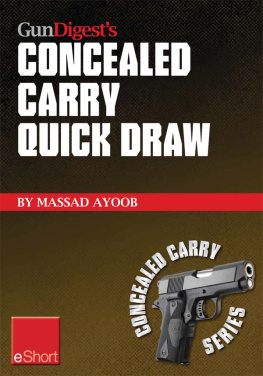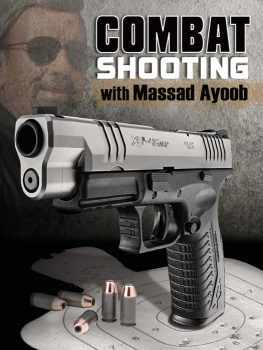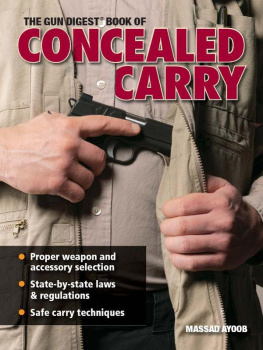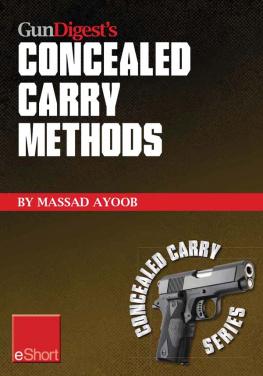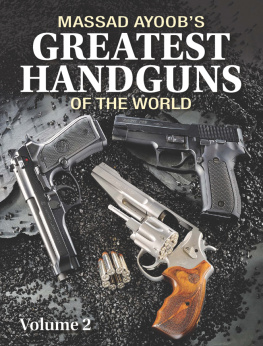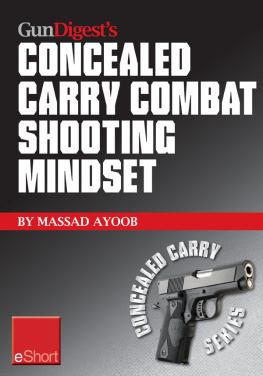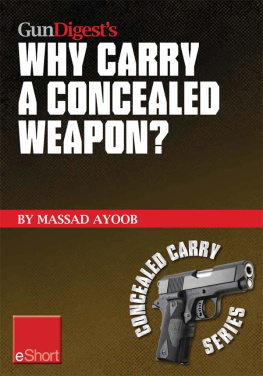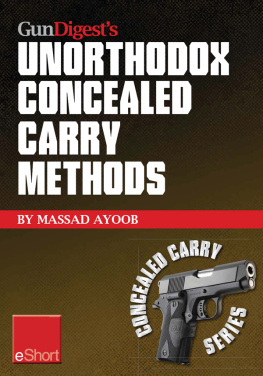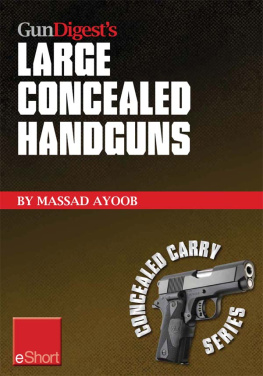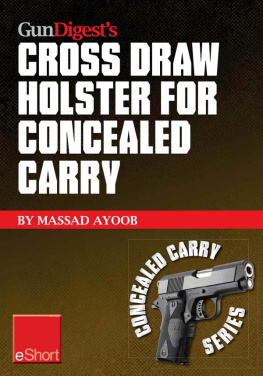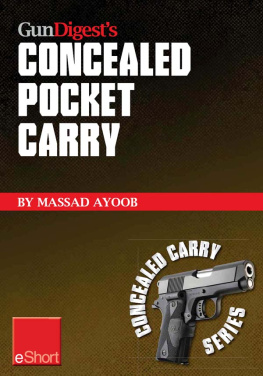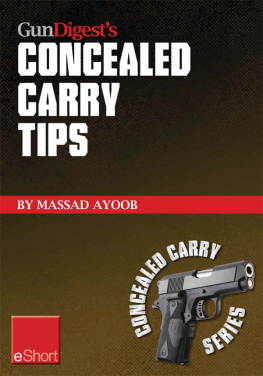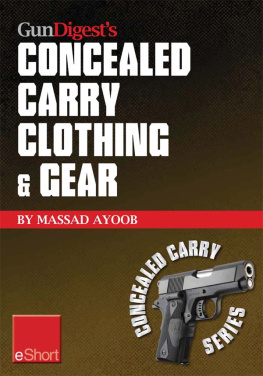Massad Ayoob - Gun Digests Concealed Carry Quick Draw eShort
Here you can read online Massad Ayoob - Gun Digests Concealed Carry Quick Draw eShort full text of the book (entire story) in english for free. Download pdf and epub, get meaning, cover and reviews about this ebook. year: 2012, publisher: F+W Media, genre: Home and family. Description of the work, (preface) as well as reviews are available. Best literature library LitArk.com created for fans of good reading and offers a wide selection of genres:
Romance novel
Science fiction
Adventure
Detective
Science
History
Home and family
Prose
Art
Politics
Computer
Non-fiction
Religion
Business
Children
Humor
Choose a favorite category and find really read worthwhile books. Enjoy immersion in the world of imagination, feel the emotions of the characters or learn something new for yourself, make an fascinating discovery.
- Book:Gun Digests Concealed Carry Quick Draw eShort
- Author:
- Publisher:F+W Media
- Genre:
- Year:2012
- Rating:5 / 5
- Favourites:Add to favourites
- Your mark:
- 100
- 1
- 2
- 3
- 4
- 5
Gun Digests Concealed Carry Quick Draw eShort: summary, description and annotation
We offer to read an annotation, description, summary or preface (depends on what the author of the book "Gun Digests Concealed Carry Quick Draw eShort" wrote himself). If you haven't found the necessary information about the book — write in the comments, we will try to find it.
In this excerpt from the Gun Digest Book of Concealed Carry, Massad Ayoob gives practical tips and advice on how to draw your gun more quickly from concealment. Learn how to draw from hip holsters, pocket and ankle holsters and shoulder holsters.
Gun Digests Concealed Carry Quick Draw eShort — read online for free the complete book (whole text) full work
Below is the text of the book, divided by pages. System saving the place of the last page read, allows you to conveniently read the book "Gun Digests Concealed Carry Quick Draw eShort" online for free, without having to search again every time where you left off. Put a bookmark, and you can go to the page where you finished reading at any time.
Font size:
Interval:
Bookmark:

More Americans than ever can now legally carry their handguns concealed. However, not very many of them have as much training and practice in bringing them into action from concealment as some of us would like to see. Even in law enforcement, it is common for plainclothes officers, and cops qualifying with their off duty weapons, to draw from exposed holsters when firing for the record on training days. In NRAs training programs for civilians, the shooter always starts with the pistol or revolver in low ready. If by definition the gun is carried concealed, it is an absolutely critical skill to be able to draw it swiftly, smoothly, and safely from hiding.
There is a lot of bad advice out there on drawing techniques. Some that Ive seen demonstrated are nothing less than hazardous. Others are, at best, less efficient than they could be. Lets look at ways of bringing the concealed handgun to bear from the most common carry locations.
First, a few general points, geared primarily to safety.
Do your initial practice with a dummy gun or unloaded gun. Its the equivalent of a student pilot learning on a simulator before taking an actual aircraft aloft. The student should be well practiced and confident in the draw before it is attempted with a loaded gun.
Always keep the finger completely outside the trigger guard until the gun is drawn and on target, and the decision to fire immediately has been made! Strict adherence to this rule would probably do more to reduce accidental shootings than any other one thing.
Holster as carefully as you draw, with the finger outside the trigger guard and the handgun on safe or decocked. Today, most good quality holsters have covered trigger guards. This industry-wide design change has done much to reduce instances of individuals shooting themselves accidentally as they draw. However, we are seeing too many cases of people shooting themselves while holstering. If the finger is left on the trigger, the portion of the holster that covers the guard interdicts the finger and holds it against the trigger, forcing the trigger back as the holstering movement continues.
Always practice drawing with the gun in a safe direction, bringing it to bear on something that can function as a backstop should the gun accidentally discharge. This is one more safety net for training. I recommend that those who own body armor use the vest set against a wall or on a chair for this purpose. The Better Bilt Safe Direction unit is expressly designed for this sort of thing.
The most popular carry position among savvy pistol-packers seems to be on the strong-side hip, concealed by an open-front upper body garment. There are many trick techniques for getting at the gun in this location, but many of them dont work if youre seated, up against the wall, or otherwise positioned where the garment cant be swung out behind the holster to clear a path for the reaching hand. I designed the following technique to solve those problems.
Let the gun hand come in and touch the torso at the centerline with all four fingertips, and then maintaining fingertip contact with your torso sweep the hand back to the gun. The bottom edge of the hand will not only clear the coat or vest or whatever under the adverse circumstances described above, but will hold it back out of the way long enough to gain a grasp of the grip-frame if something happens to slow the draw.
Once your hand gets there, grasp the handgun firmly with all fingers but the index, which should be straight outside the holster. The web of the hand should be at the highest possible point on the grip frame. The thumb will at this point release the safety strap if one is in place. Keeping the elbow joint pointed to the rear (so the long bones of your arm will be in line with the direction in which youll be applying force), clear the gun from the holster with a rock and lock movement that levers the muzzle up toward the target as soon as possible. Now, drive the gun forward toward the target.
Throughout the draw so far, the support hand has been at midline of the body. For a combat draw, I prefer the fingertips of the support hand to be pointed forward, which gives the arm more leverage to resist a grab by a close-range opponent. Now, as the gun is coming forward, the support hand takes its position on the firing hand. Be certain that the muzzle of the handgun is well ahead of the support hand before this part of the operation is put into effect.
You now flow into your stance of choice. A double-action auto carried on safe can be thumbed into the fire position anywhere during this procedure, but a cocked and locked single-action auto should remain on safe, with the thumb in position on the manual safety, until the decision to fire is made. Only when that decision is made should the trigger finger enter the guard; it should have been in register throughout the draw, that is, with the pad or tip of the trigger finger touching the frame above the trigger guard.
If the gun is under a buttoned or pullover shirt, a pullover sweater, an anorak or similar garment, it will be more difficult to access. All the same basic rules are in play, you just have to work a little harder.
If both hands are free, grasp the garment at its hem in front of the holster with the free hand, and jerk it upward as high toward the gun arms shoulder as you can. You may not have enough play in the garment to get the hem that high, but if you try for the shoulder you will probably at least clear the holster area enough for a clean draw. The gun hand now draws exactly the same as it would with the holster in the same strong side position. As the gun comes clear, rock the muzzle on target. The support hand will come in from above and behind the gun, safely clear of the muzzle. This two-handed technique was popularized by my old friend Ken Hackathorn.
Unfortunately, you wont always have both hands free for this purpose, so of necessity you want to devote about half of your practice drawing from under closed-front garments to the following one-handed technique. Extend the gun hands thumb toward the body and let it track up the seam of the trousers, or along the common peroneal nerve, toward the gun. This will allow the thumb to lift the garment enough to gain the proper drawing grasp. From there, the draw is the same as above, with one difference: to gain more clearance, I bend my knee slightly on the gun hand side and drop the hip, pulling the gun down and out from under any remaining fabric to prevent it from snagging.
Let me tell you how practice ingrains a technique. Early in 2005, I took a busmans holiday and attended one of my friend and colleague Chuck Taylors excellent shooting classes as a student. When I was drawing my Glock 17 from under my open-front Royal Robbins 5.11 Concealment Vest, Chuck asked me, Why do you bend your right knee when you draw? I was stumped; I didnt even know Id been doing it. It took me a day to figure out that what I was doing was born of decades of practice in drawing my off-duty gun, usually a 4-inch barrel service revolver or 5-inch barrel combat auto, from under the un-tucked polo or tee shirt that normally concealed it off duty in hot weather. The practice had harmlessly, it turns out transferred itself to my regular concealed draw from under an open-front garment.
Any carry in which the gun is on the side of the body opposite the dominant hand, either butt forward or suspended horizontally or upside down, is some variation of what is called a cross draw. The term cross draw is normally applied to a gun holstered on the belt in a butt forward position, but the popular shoulder holster is a variation of cross draw. So is the common practice of attaching a small handguns holster to the straps on concealed body armor, carrying the gun beneath the armpit on the non-dominant side.
Font size:
Interval:
Bookmark:
Similar books «Gun Digests Concealed Carry Quick Draw eShort»
Look at similar books to Gun Digests Concealed Carry Quick Draw eShort. We have selected literature similar in name and meaning in the hope of providing readers with more options to find new, interesting, not yet read works.
Discussion, reviews of the book Gun Digests Concealed Carry Quick Draw eShort and just readers' own opinions. Leave your comments, write what you think about the work, its meaning or the main characters. Specify what exactly you liked and what you didn't like, and why you think so.

